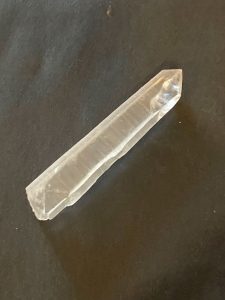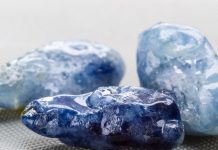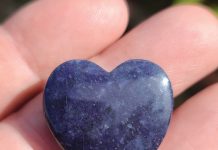
Types of gemstones include the commonly known, like quartz and ruby, and others less familiar. Here we cover the facts and history of gemstones from the letters J to R. The beauty of this exercise is that it allows us to delve into lesser-known specimens or to possibly learn something new about an old favorite. This is the second in a three-part series covering types of gemstones by letter starting with the letters A to I and ending with the types of gemstones with the letters S to Z.
Jasper

Jasper is found throughout the world. This chalcedony is a cryptocrystalline form of silica. Jasper types of gemstones come in colors ranging from green, red, blue, orange, yellow and brown. The colors are because of impurities such as ash, clay or minerals within the stones. Iron typically creates the reddish hues, while manganese oxide is responsible for blues, and inclusions of iron oxide or the mineral goethite create the yellows.
Many times there are types of gemstones with examples of various inclusions, such as with the bloodstone jasper, where chlorite and pyroxene cause the deep green, while iron is responsible for the red speckling. Jasper’s name is based on the French word “jaspre” which came from the Latin “jaspidem” meaning “speckled stone.” This is fitting because when polished, jasper has a speckled pattern seemingly just below the surface.
Kunzite
The best-known variety of spodumene, kunzite is the pink to purple version of this important mineral that is still sometimes mined for lithium production. Kunzite boasts beautiful pink or purplish hues because of the presence of manganese, while chromium creates the greens of another variety, hiddenite.
A fascinating aspect of kunzite is its pleochroic attributes where it displays different colors, such as a combination of pink, purple and transparent, depending on which way you look through the crystal. This is a key consideration when cutting the gem. It also has phosphorescence, which allows the stone to absorb light and then release it in the dark, as with any of our favorite glow-in-the-dark items. The drawback is excessive exposure to sunlight fades its beautiful colors.
With a Mohs rating of 7, eye-catching colors, and the unique characteristics of pleochroism and phosphorescence, it’s even more intriguing to know that large crystals are possible with the best example being an 880-carat heart-shaped kunzite housed at the Smithsonian.

Lapis Lazuli
The beautiful deep blue lapis lazuli is an example of when a gemstone is not a mineral. Instead, lapis lazuli is a rock consisting of multiple minerals, including lazurite, calcite, pyrite, afghanite and several others.
To be considered true lapis lazuli, the rock has to contain at least 25 percent of the mineral lazurite that lends to the distinct blue coloration. Calcite is usually the next most prevalent mineral which often shows up as white layers or mottling. Pyrite provides the shiny gold flecks in some specimens.
Afghanistan is the hotbed of lapis lazuli. There are records of it being mined in the Badakhshan Province of the northeastern part of the country as early as 7000 B.C. The name is derived from the Arabic word “lazaward” meaning “heaven” along with the Persian term for blue, “lazhuward.” In ancient times, Egyptian women also used powdered lapis as an eye shadow. And even in the 1800s, powdered lapis was used to create ultramarine blue paint used in oil canvas paintings, such as Vincent Van Gogh’s “The Starry Night.”

Malachite
A vibrant green gemstone with distinct parallel banding, malachite is a striking specimen and its popularity for thousands of years is no surprise. Derived from the Greek word meaning “mallows,” this correlates to the deep green of malachite with the color of the mallow plant’s leaves.
The gem color is derived from the copper carbonate hydroxide minerals often found in regions near copper deposits. Because malachite is a fairly malleable oxidized copper ore, it’s possible to extract copper from it using sulfuric acid.
The Egyptians also figured out how to remove the copper by placing powdered malachite in a hot fire, which resulted in tiny spheres of copper as a by-product. They used this copper to make cookware, and razors and eventually created stronger bronze by adding arsenic or tin. They also used finely ground gemstones as a distinctive eye paint. Besides adorning the appearance of ancient Egyptians, malachite is one of the oldest known pigments and was identified in the artwork of Egyptian tombs.
Natrolite
Typically found with slender, needle-like crystals protruding from the crystal, natrolite is an eye-catching specimen. It’s difficult to imagine such a fragile-looking stone cut and polished into impressively faceted gems, although high-quality gems are truly rare. Not surprisingly, it’s sometimes called needle stone.
Natrolite leans toward a colorless appearance but can be found in white, light yellow, green, orange, pink, brown or gray. When it’s placed under either longwave or shortwave ultraviolet light, it glows in yellow, orange and sometimes pale green.
A member of the zeolite group, which are hydrated aluminosilicate minerals, the name comes from the Greek words for soda and stone, “natron” and “lithos.” It was officially named by the German chemist Martin Heinrich Klaproth in the early 1800s. Natrolite is found in regions where there are veins of basaltic rocks, along with granite and the igneous rock, gneiss.
Onyx
While onyx and agate are both types of chalcedonies and share many similarities, one way to tell them apart is to look at their banding. Agate sports curved bands and onyx has straight, parallel banding. When many people envision onyx, they think of a black gem but is often found in red, brown or yellow, which is called sardonyx. Red and white layers are usually what is referred to as carnelian onyx, while Nicolo onyx has light blue layers alternating with black.
Since ancient times, artists have created intricately carved cameos. Black onyx grew in popularity during the Victorian Era when mourning jewelry was an integral part of society. After Queen Victoria’s husband Prince Albert passed away in 1861, she and all of the British Empire descended into mourning. Besides onyx, jet, vulcanite and even black enamel were used in the adornments. Many included personal mementos, such as hair, woven into the locket or watch fob.
Peridot
Peridot is the gem variety of the common mineral olivine and one with a unique origination story. Unlike many other minerals that form on the Earth’s surface, peridots are birthed either deep within the Earth’s upper mantle where they are brought to the surface through volcanic activity, or deposited by meteorites.
Because of this relationship with volcanoes, Hawaiian legend claims that peridot symbolizes the tears of Pele, the goddess of volcanoes and fire. It is so intertwined that there are several beaches on the island of Oahu that are made up of green sand that glitters with these tiny green crystals. Its distinct coloration is because of the percentage of iron in the formation of the crystals, yet can vary to the point where the stone looks more yellow, olive or even greenish-brown.
The ancient Egyptians referred to peridots as the “gem of the sun,” and some experts surmise that Cleopatra’s famed emeralds may have actually been peridot gemstones.

Quartz
Quartz might not only be one of the most abundant minerals found on Earth, but it is also possibly one of the most useful as it is found in everything from glass to electronics, and has been critical in the mining industry. One fascinating aspect of quartz crystals is their vibrational ability.
As a piezoelectric material, quartz creates an electrical charge when it’s squeezed. As a result, it vibrates 32,768 times per second, and for nearly a century, quartz crystals have been used in watches, computers, GPS units and a remarkable number of everyday items. Found in several varieties, types of gemstones include rosy quartz, smoky quartz and amethyst, quartz is as diverse as it is beautiful. The coloration differences are often due to natural radiation reacting with specific minerals within the quartz. For instance, iron is responsible for the purple hue of amethyst while aluminum creates the gray of the smoky quartz.
Ruby
The terms “ruby” and “red” are practically synonymous, or at the very least, ruby is often used as an adjective to describe types of gemstones with a particular shade of color. Its name comes from the Latin word for red, “ruber.” Bringing the highest per-carat price of any of the colored stones in the modern market, rubies shine among the corundums, which also include sapphires. Like sapphires, they score high on the Mohs scale ranking just below a diamond.
Pure corundums are colorless, but chromium causes the striking red coloration of rubies. The deeper the color, the more chromium is present. This element also causes rubies to glow under ultraviolet light. Because of rubies’ chemical composition, the first working laser, called the ruby laser, was created in 1960 by Theodore Maiman. One of its first uses was in range-finding equipment, but the technology is used to this day as a light source for medical procedures or high-speed photography.
As this list demonstrates, types of gemstones go well beyond only beautiful objects. The myriad of important day-to-day applications for gemstones gives us a deeper appreciation of what might be considered common gems.
This story about types of gemstones by letter appeared in Rock & Gem magazine. Click here to subscribe. Story by Amy Grisak.













